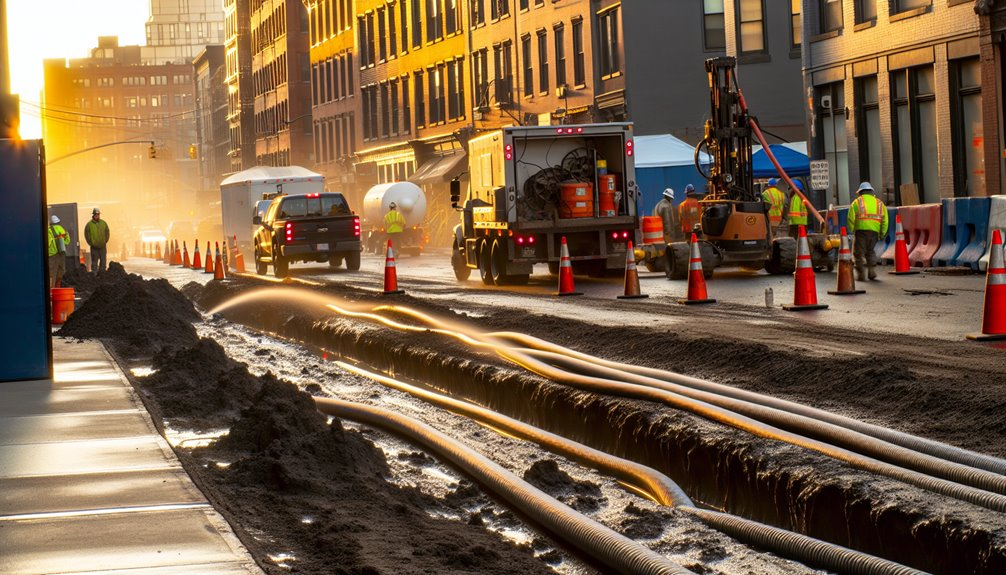As you commence your next trenching project, it's vital you grasp fully how stringent management of both timelines and budgets can propel your success. Start by integrating robust project management software; this not only enhances task prioritization but also keeps your financial tracking in real-time. Remember, the key lies in balancing meticulous planning with flexible execution. Stay tuned for essential strategies on steering through the complexities of budget constraints and scheduling conflicts without compromising the quality of your trench work.
Understanding the Scope and Requirements of Trenching Projects

Why should we care about the meticulous planning of trenching projects? A well-planned trenching operation guarantees efficiency, compliance, and most importantly, trench safety.
You must begin by thoroughly understanding the area's topography through detailed surveys, marking essential utilities to avoid disruptive or dangerous hits. Innovative excavation techniques, such as precisely calculating the minimum trench width and depth, are critical.
This isn't just about making cuts in the earth; it's about maintaining structural integrity through strategic bracing and shoring, particularly in varied soil conditions.
Every step, from site preparation to the final backfill, demands strict adherence to safety standards to protect your team. Efficiently managed trenching sets the foundation for project success and safety. Moreover, adhering to depth requirements ensures that cables are adequately protected and comply with safety regulations.
Early Engagement and Collaboration With Stakeholders
You'll find that identifying stakeholders early in your trenching project is essential for timely and effective communication. Developing a strategic approach to stakeholder engagement can streamline collaborative planning and greatly enhance project outcomes. This process not only guarantees that all voices are heard but also aligns project goals with stakeholder expectations, optimizing both time and resources. Early stakeholder involvement eliminates waste by addressing potential inefficiencies from the onset, fostering a more streamlined project execution.
Stakeholder Identification Process
Initiating a project successfully hinges on accurately identifying and engaging stakeholders early in the process.
You'll start with a thorough stakeholder analysis using your project charter to pinpoint key sponsors, clients, and influencers. Immerse yourself in existing documents, contracts, and agreements to unearth both internal and external stakeholders.
Don't overlook industry research and consultations with seasoned experts, which are invaluable for recognizing less obvious stakeholders. Engaging local communities through forums or surveys will also illuminate concerns and expectations early on.
Effective engagement strategies involve prioritizing stakeholders based on their influence and interest.
This approach guarantees that you're allocating resources wisely and addressing potential risks proactively, setting a solid foundation for the project's success.
Communication Strategy Development
After identifying your project's stakeholders, developing a robust communication strategy is vital for early engagement and effective collaboration.
You'll need to establish a clear communication chain, defining each team member's role to improve accountability and reduce confusion. Make sure everyone knows who to contact for specific updates or issues.
Selecting the right communication methods—whether emails, phone calls, or digital tools like construction management software—is essential. You should tailor these tools to the urgency and nature of the message to enhance message clarity.
Hold regular meetings to make certain all teams are aligned, using these opportunities to reinforce roles, responsibilities, and the progress of your trenching project.
This structured approach will streamline your communications, keeping your project on track and within budget.
Collaborative Planning Benefits
Engaging stakeholders early in the planning process greatly enhances the efficiency and success of trenching projects. By aligning everyone with the project's Conditions of Satisfaction through early stakeholder engagement, you eliminate waste, reduce duplicate efforts, and prevent unnecessary tasks.
This proactive approach not only streamlines resource allocation but also markedly cuts costs by minimizing rework and delays.
Project collaboration guarantees all parties are on the same page, improving decision-making and fostering a cohesive team environment. You'll see a noticeable uptick in innovation as diverse inputs converge, leading to groundbreaking solutions.
Furthermore, collaborative planning keeps your project within budget and on schedule, as early engagement provides ample time to address potential bottlenecks and develop contingency plans for unforeseen challenges.
Selection and Integration of Technological Solutions

To effectively manage your trenching project's timeline and budget, selecting and integrating the right technological solutions is essential.
You'll want to harness the latest technological advancements, such as precision trenching attachments that cut with exactness and reduce over-excavation.
Coupling these tools with software integration can streamline your operations dramatically.
Utilize centralized project management software to oversee schedules, manage resources, and facilitate seamless communication among your team.
This integration not only optimizes your project management processes but also enhances your ability to respond to real-time project demands.
Implementing Effective Scheduling Techniques
To manage your trenching project effectively, you must prioritize critical tasks that directly impact your timeline.
Utilizing advanced project management tools will enable you to visualize task sequences and dependencies clearly, ensuring no detail is overlooked.
This strategic approach not only keeps your project on track but also guards against budget overruns and scheduling conflicts.
Prioritize Critical Tasks
When managing trenching projects, prioritizing vital tasks is essential for keeping your schedule on track and within budget.
Begin by defining project objectives and requirements, coordinating with stakeholders to identify key milestones.
Next, employ task prioritization techniques like critical path analysis to discern dependencies and sequence tasks effectively.
Assess each task's urgency and importance, using tools like the Eisenhower Matrix to classify and prioritize accordingly.
Consider constraints such as budget and resource availability, adjusting task priorities to address these limitations.
Regularly reassess priorities based on project evolution, ensuring key path tasks are always foregrounded.
This strategic focus will streamline your operations, minimizing delays and optimizing resource allocation for maximum efficiency and project success.
Utilize Project Management Tools
In the fast-paced world of trenching projects, utilizing advanced project management tools is essential to maintain control over your schedules and budgets.
Implementing effective scheduling techniques like the Critical Path Method helps you identify the sequence of vital tasks, optimizing project tracking and task prioritization.
With Gantt charts, you're not just planning; you're visually mapping out timelines, spotting overlaps, and dependencies at a glance.
Adopt the Program Evaluation and Review Technique to adjust for uncertainties in task durations, ensuring flexibility in your planning process.
Don't overlook the power of Fast Tracking—by overlapping tasks where feasible, you'll greatly cut down project time.
Embrace these tools to steer your projects with precision, keeping them on track and within budget.
Budget Forecasting and Cost Control Measures
As you plan your trenching project, understanding budget forecasting methods and cost control measures is essential for staying on track financially.
Here are key strategies to implement:
- Leverage Historical Data Analysis: Use past project data to forecast your budget, giving you a realistic baseline and helping anticipate future financial needs.
- Adopt Zero-Based Budgeting: Start from zero each budget cycle, ensuring every dollar spent is justified, promoting efficiency and cutting excess costs.
- Utilize Real-Time Tracking: Monitor expenses as they occur using advanced software. This keeps your project aligned with the budget, allowing immediate adjustments.
- Conduct Regular Variance Analysis: Compare projected costs against actuals regularly, identifying discrepancies early and adjusting to avoid budget overruns.
Risk Assessment and Management Strategies
After establishing a solid plan for budget forecasting and cost control, it's crucial to focus on identifying and managing risks to guarantee your trenching project proceeds safely and smoothly.
You'll start by pinpointing hazards such as cave-ins, utility contact, and hazardous atmospheres. Utilize DBYD and thorough site inspections to locate underground services and evaluate risks like trench collapses or electrocution.
Implement hazard mitigation strategies including engineering controls like shoring and trench boxes for deeper excavations.
Additionally, prioritize risk monitoring through continuous site evaluations and updating risk assessments, particularly after any incidents.
Quality Assurance and Compliance in Trenching Operations
To guarantee your trenching operations meet both quality standards and regulatory compliance, you must develop a thorough work plan for each excavation.
Here's how you can ascertain robust quality assurance and strict compliance verification:
- Initiate Compliance Checks: Start with verifying operator qualifications and ascertain a Competent Person oversees the site, meeting OSHA requirements.
- Implement Protective Systems: For excavations deeper than five feet, utilize approved protective systems. This is critical for both safety and compliance.
- Conduct Regular Inspections: Perform daily inspections and additional checks post any significant event like rainstorms to maintain safety standards.
- Document Everything: Keep detailed records of all compliance verification activities and nonconformances to streamline audits and enhance accountability.
Continuous Monitoring and Project Adjustment Methods
Implementing continuous monitoring and making adjustments to your trenching project are essential for managing timelines and budgets effectively.
Utilize advanced monitoring systems that leverage IoT and wireless technologies for real-time data analytics. These systems, compatible across various shoring systems, enable early detection of issues like excessive forces or wall deflection through telemetric pins. You'll receive instant alarm notifications on your cell phone, prompting immediate corrective actions.
Adjust construction practices based on continuous feedback from web-based reporting and real-time analysis.
Consider soil conditions, adjust excavation methods accordingly, and select appropriate equipment to enhance safety and efficiency.
Conclusion
To effectively manage your trenching projects, you'll need to stay proactive. Engage stakeholders early, utilize cutting-edge technology, and apply stringent scheduling and budgeting techniques. Always assess risks and enforce quality assurance rigorously. By continuously monitoring and adapting to site conditions and feedback, you guarantee your project not only meets but exceeds expectations. Remember, managing timelines and budgets accurately is key to maintaining cost-efficiency and achieving successful project outcomes. Stay vigilant and responsive to keep your projects on track.
If you're looking to dive deeper into trenching services and discover how we can assist you, I invite you to visit us at Boring Bros at boringbro.com. You can also give us a call at (954) 639-6167. We'd love to chat and help you navigate your next project with ease!




